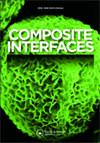Mechanical properties of N440/SiO2 composites with fugitive carbon interphases
IF 2.4
4区 材料科学
Q3 MATERIALS SCIENCE, COMPOSITES
引用次数: 0
Abstract
ABSTRACT Mechanical properties of NextelTM 440 fiber-reinforced SiO2 composites containing fugitive carbon (FC) interphases were investigated. The three-point bending (TPB) test at room temperature indicated that FC interphases were crucial to the strength improvement. After employing FC interphases, the fiber/matrix bonding strength was weak enough for crack propagation, thus leading to the increase of flexural strength by about 2.1 times. The TPB test at high-temperature showed that the flexural strength decreased firstly and then increased as temperature increased, and the fracture mode changed from ductile to brittle. The lowest value of 92.3 ± 13.5 (MPa) was obtained at 1000°C. With the aid of the single edge notched beam test combined with the digital image correlation technique, cracks propagation process during fracture was well clarified.含挥发性碳界面相N440/SiO2复合材料的力学性能
研究了NextelTM 440纤维增强含逸散碳(FC)界面相SiO2复合材料的力学性能。室温三点弯曲(TPB)试验表明,FC界面相对强度的提高至关重要。采用FC界面相后,纤维/基体结合强度弱到足以裂纹扩展,从而使抗弯强度提高了约2.1倍。高温TPB试验表明,随着温度的升高,材料的抗弯强度先降低后升高,断裂方式由延性向脆性转变。在1000℃时,最小值为92.3±13.5 (MPa)。借助单边缘缺口梁试验结合数字图像相关技术,较好地阐明了断裂过程中裂纹的扩展过程。
本文章由计算机程序翻译,如有差异,请以英文原文为准。
求助全文
约1分钟内获得全文
求助全文
来源期刊

Composite Interfaces
工程技术-材料科学:复合
CiteScore
5.00
自引率
3.80%
发文量
58
审稿时长
3 months
期刊介绍:
Composite Interfaces publishes interdisciplinary scientific and engineering research articles on composite interfaces/interphases and their related phenomena. Presenting new concepts for the fundamental understanding of composite interface study, the journal balances interest in chemistry, physical properties, mechanical properties, molecular structures, characterization techniques and theories.
Composite Interfaces covers a wide range of topics including - but not restricted to:
-surface treatment of reinforcing fibers and fillers-
effect of interface structure on mechanical properties, physical properties, curing and rheology-
coupling agents-
synthesis of matrices designed to promote adhesion-
molecular and atomic characterization of interfaces-
interfacial morphology-
dynamic mechanical study of interphases-
interfacial compatibilization-
adsorption-
tribology-
composites with organic, inorganic and metallic materials-
composites applied to aerospace, automotive, appliances, electronics, construction, marine, optical and biomedical fields
 求助内容:
求助内容: 应助结果提醒方式:
应助结果提醒方式:


